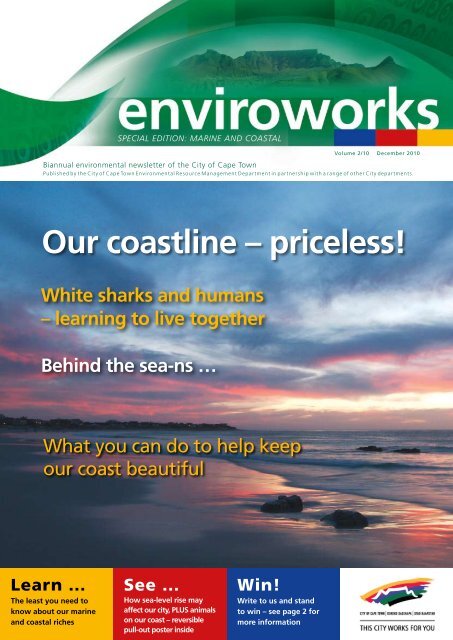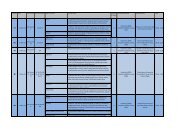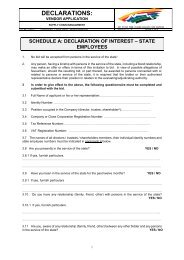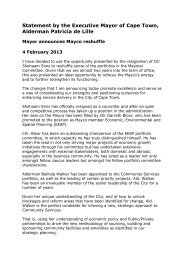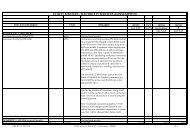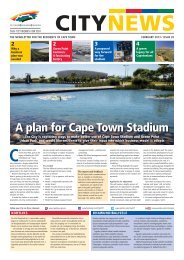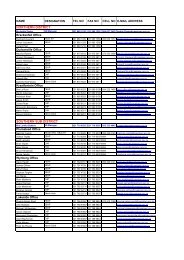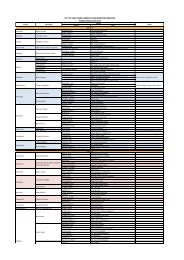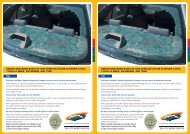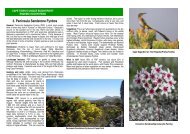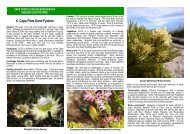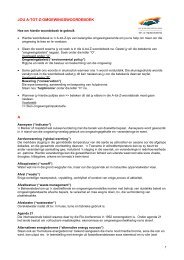Our coastline – priceless! - City of Cape Town
Our coastline – priceless! - City of Cape Town
Our coastline – priceless! - City of Cape Town
You also want an ePaper? Increase the reach of your titles
YUMPU automatically turns print PDFs into web optimized ePapers that Google loves.
special edition: Marine and coastal<br />
Volume 2/10 December 2010<br />
Biannual environmental newsletter <strong>of</strong> the <strong>City</strong> <strong>of</strong> <strong>Cape</strong> <strong>Town</strong><br />
Published by the <strong>City</strong> <strong>of</strong> <strong>Cape</strong> <strong>Town</strong> Environmental Resource Management Department in partnership with a range <strong>of</strong> other <strong>City</strong> departments.<br />
<strong>Our</strong> <strong>coastline</strong> <strong>–</strong> <strong>priceless</strong>!<br />
White sharks and humans<br />
<strong>–</strong> learning to live together<br />
Behind the sea-ns …<br />
What you can do to help keep<br />
our coast beautiful<br />
Learn ...<br />
The least you need to<br />
know about our marine<br />
and coastal riches<br />
See ...<br />
How sea-level rise may<br />
affect our city, PLUS animals<br />
on our coast <strong>–</strong> reversible<br />
pull-out poster inside<br />
Win!<br />
Write to us and stand<br />
to win <strong>–</strong> see page 2 for<br />
more information
2 special edition: Marine and coastal<br />
Brian Preen<br />
Contents<br />
<strong>Our</strong> <strong>coastline</strong> <strong>–</strong> <strong>priceless</strong>! 3<br />
Flying the Blue Flag for <strong>Cape</strong> <strong>Town</strong> 4<br />
Why we need our <strong>coastline</strong><br />
and oceans 6<br />
A dynamic, ever-changing space 8<br />
Animals along our coast 9<br />
Climate change and sea-level rise<br />
<strong>–</strong> what can we expect? 10<br />
<strong>Our</strong> <strong>coastline</strong><br />
<strong>–</strong> under immense pressure 13<br />
Taking action to protect<br />
our <strong>coastline</strong> 14<br />
Coastal partners 16<br />
Behind the sea-ns … 17<br />
White sharks and humans<br />
<strong>–</strong> learning to live together 18<br />
What you can do to help keep<br />
our coast beautiful 20<br />
This newsletter is printed on<br />
SAPPI Triple Green paper, an<br />
environmentally friendly paper<br />
stock made from chlorine-free<br />
sugar cane fibre to support<br />
sustainable afforestation in<br />
South Africa.<br />
COngrATULATiOnS to all our winners!<br />
Feedback competition<br />
Prize: Two tickets to the<br />
Two Oceans Aquarium<br />
Winner: Sue Oosthuizen<br />
Biodiversity poster competition<br />
Thank you to everyone who entered<br />
<strong>–</strong> choosing the winners was a difficult<br />
task! There were no entries in the age<br />
category up to 7, or in the category<br />
15<strong>–</strong>18. The winners in the other<br />
two categories (and their prizes) are<br />
as follows …<br />
8<strong>–</strong>10 years:<br />
1st <strong>–</strong> Alexandra van der Spuy, 9 (bush<br />
adventure with ten friends, or<br />
bush-camp sleepover)<br />
2nd <strong>–</strong> Keegan Weaver, 9 (battery-free<br />
flashlight and radio)<br />
3rd <strong>–</strong> Shivaan Pillay, 9 (can crusher)<br />
11<strong>–</strong>14 years:<br />
1st <strong>–</strong> John Peddie, 12 (bush adventure<br />
with ten friends, or bush-camp<br />
sleepover)<br />
2nd <strong>–</strong> Katerine van der Spuy, 11 (solar<br />
garden light)<br />
3rd <strong>–</strong> Jason Weaver, 12 (notebook and<br />
pencil from recycled material)<br />
FEEDBACK from readers<br />
Thank you to everyone who provided feedback on the previous issue <strong>of</strong> Enviroworks,<br />
or entered the competitions. We would like to keep the conversation going and<br />
<strong>of</strong>fer a copy <strong>of</strong> Thomas Peschak’s beautiful c<strong>of</strong>fee-table book Wild Seas, Secret<br />
Shores <strong>of</strong> Africa to the best letter received. So, if you have anything on your<br />
mind, please use the details at the bottom <strong>of</strong> this page to air your views!<br />
Write to us and stand to<br />
Environmental Resource Management Department, <strong>City</strong> <strong>of</strong> <strong>Cape</strong> <strong>Town</strong>, 44 Wale Street, <strong>Cape</strong> <strong>Town</strong> 8001<br />
PO Box 16548, Vlaeberg 8018 • Tel: 021 487 2284 • Fax: 021 487 2255 • E-mail: enviroworks@capetown.gov.za<br />
Website: www.capetown.gov.za/environment<br />
This publication is available online as well. In the interest <strong>of</strong> the environment, you are encouraged to<br />
subscribe to the electronic version <strong>of</strong> this publication instead. Please send an e-mail to enviroworks@<br />
capetown.gov.za to receive a pdf version by e-mail in future.<br />
Photography: Carl Fourie or <strong>City</strong> <strong>of</strong> <strong>Cape</strong> <strong>Town</strong> employees unless indicated otherwise | Copy: Nyani Communication<br />
Design: G2 Design | Printing: Tandym Print<br />
Western leopard toad competition<br />
Prize: Two tickets to the<br />
Two Oceans Aquarium<br />
Winners: Daniël de Vaal;<br />
Fauwzia Holland<br />
1st prize 8-10 years<br />
1st prize 11-14 years<br />
Win!
<strong>Our</strong> <strong>coastline</strong> <strong>–</strong> <strong>priceless</strong>!<br />
With 240 km <strong>of</strong> coast to administer,<br />
the <strong>City</strong> <strong>of</strong> <strong>Cape</strong> <strong>Town</strong> faces<br />
significant challenges. The coastal<br />
ecosystems and associated services<br />
provide critical support to our coastal<br />
population. However, due to increased<br />
demand and pressure on these<br />
systems and services, our coastal<br />
environment is changing. Instead <strong>of</strong><br />
dynamic spaces, we have <strong>–</strong> through<br />
poor planning and overdevelopment<br />
<strong>–</strong> created artificial, fixed spaces. If<br />
we do not turn this around, we will<br />
eventually smother the natural and<br />
dynamic coastal systems; they will no<br />
longer function and we will lose the<br />
benefits and services we have taken<br />
for granted (more on page 6).<br />
FocUs on oUr Marine and coastal assets<br />
Most <strong>of</strong> us have fond childhood memories <strong>of</strong> holidays spent on the beach <strong>–</strong> swimming, playing beach<br />
games, or exploring rock pools. As adults, we appreciate the beach in a different way <strong>–</strong> whether for<br />
long, romantic walks; adrenalin-packed water sports, or simply to bask in the sun. Yet, few <strong>of</strong> us<br />
consider the economic, social and environmental value <strong>of</strong> the <strong>coastline</strong>; even fewer realise that it is a<br />
dynamic space that requires care and attention.<br />
An angler tries his luck at Bikini Beach.<br />
Did you know?<br />
In 1580, British navigator Sir Francis<br />
Drake passed the <strong>Cape</strong> <strong>of</strong> Good<br />
Hope, and later wrote: “This cape<br />
is a most stately thing and the<br />
fairest cape we saw in the whole<br />
circumference <strong>of</strong> the earth.”<br />
This issue <strong>of</strong> Enviroworks is therefore<br />
dedicated to our greatest (yet mostly<br />
overlooked) asset <strong>–</strong> our <strong>coastline</strong>. In<br />
the pages that follow, we look at how<br />
it works and why we need it so much.<br />
We cover some <strong>of</strong> the initiatives the<br />
<strong>City</strong> <strong>of</strong> <strong>Cape</strong> <strong>Town</strong> has launched to<br />
manage and protect our <strong>coastline</strong>, and<br />
also explore how we can help care<br />
for it today, so that our children and<br />
grandchildren will still be able to enjoy<br />
its benefits long after we are gone.<br />
Children and their parents enjoy a sunny day on St James Beach.<br />
! The least you<br />
need to know<br />
<strong>Our</strong> <strong>coastline</strong> is our city’s most<br />
valuable economic and social<br />
asset. We should stop taking<br />
it for granted and start taking<br />
joint responsibility for it.<br />
More information<br />
CAPE TOWN’S COASTLINE:<br />
www.ngo.grida.no/soesa/nsoer/issues/coast/intro.htm;<br />
www.capetownguide.com/<strong>coastline</strong>.php<br />
3<br />
i
i<br />
4 international accreditation For oUr BeacHes<br />
Flying the Blue Flag for <strong>Cape</strong> <strong>Town</strong><br />
Have you ever noticed the large blue flags flying on a number <strong>of</strong> <strong>Cape</strong> <strong>Town</strong>’s beaches? These flags<br />
attest to the fact that we have some <strong>of</strong> the top beaches in the world <strong>–</strong> right here on our doorstep!<br />
What does a beach’s Blue Flag status mean, and how does it benefit you?<br />
Young girls enjoying sea, sand and sun.<br />
The Blue Flag is an international,<br />
voluntary ‘eco-label’ that is awarded<br />
annually to beaches (and marinas) that<br />
meet certain stringent requirements.<br />
It aims to promote sustainable<br />
development through 32 criteria that<br />
span the following four aspects <strong>of</strong><br />
coastal management:<br />
• Water quality<br />
• Environmental education and<br />
information<br />
• Safety and services<br />
• Environmental management<br />
More information<br />
The Blue Flag has become a symbol<br />
<strong>of</strong> excellence. It also guarantees<br />
continued high standards <strong>of</strong> beach<br />
management, as a beach can lose<br />
its Blue Flag status if it no longer<br />
complies with the requirements.<br />
The Blue Flag programme was started<br />
in Europe in 1987, and in 2001,<br />
South Africa became the first country<br />
outside Europe to apply for, and<br />
receive, Blue Flag accreditation for a<br />
number <strong>of</strong> its beaches.<br />
INTERNATIONAL BLUE FLAG BEACHES: www.blueflag.org<br />
SOUTH AFRICAN BLUE FLAG BEACHES: www.blueflag.org.za<br />
CAPE TOWN BLUE FLAG BEACHES: www.capetown.gov.za/blueflag<br />
! The least you<br />
need to know<br />
<strong>Cape</strong> <strong>Town</strong> has a number <strong>of</strong><br />
Blue Flag beaches. Visitors<br />
to any beach carrying this<br />
international status can be<br />
assured <strong>of</strong> excellent beach<br />
cleanliness, environmental<br />
soundness, and adherence<br />
to international safety and<br />
other tourist standards.<br />
Sun-worshippers enjoy a day out at Clifton 4th Beach. Camps Bay, with the Twelve Apostles in the background.<br />
Anton Pauw
How can you<br />
benefit from Blue<br />
Flag beaches?<br />
Top quality beaches for you to enjoy<br />
You and your family and friends can enjoy these beaches<br />
in the knowledge that they are clean and environmentally<br />
safe, and <strong>of</strong>fer excellent life-saving standards, top-rate<br />
parking and spotlessly clean ablution facilities.<br />
Increased tourism and retail income<br />
Given the international accreditation that these beaches<br />
enjoy, foreign visitors are more likely to visit them. Those<br />
involved in retail around a Blue Flag beach should also<br />
see an increase in sales. This benefits individuals as well<br />
as the community as a whole.<br />
<strong>Cape</strong> <strong>Town</strong>’s Blue<br />
Flag beaches<br />
A number <strong>of</strong> <strong>Cape</strong> <strong>Town</strong> beaches<br />
have been awarded international<br />
Blue Flag status for the 2010 / 2011<br />
summer season, for excelling in safety,<br />
cleanliness, provision <strong>of</strong> amenities, and<br />
the maintenance <strong>of</strong> environmental<br />
standards. They are:<br />
• Camps Bay<br />
• Clifton 4th Beach<br />
• Mnandi<br />
• Muizenberg<br />
• Strandfontein<br />
Anton Pauw • Bikini Beach<br />
• Llandudno (pilot status); and<br />
• Silwerstroomstrand (pilot status).<br />
Lifeguards at Clifton 4th Beach proudly fly the Blue Flag.<br />
improved behaviour by beach-goers<br />
A well-managed beach reduces visitor misconduct and<br />
the consequent inconvenience or danger to others, such<br />
as broken glass bottles on the beach, or surfing in areas<br />
demarcated for swimming.<br />
increase in property prices<br />
Local authorities report that there has been a marked<br />
increase in property prices for homes near Blue Flag<br />
beaches. Specifically international buyers are partial to<br />
upmarket properties around Blue Flag beaches, such as<br />
Clifton 4th Beach.<br />
Top: The sun sets over Bikini Beach. Below: The iconic changing rooms at Muizenberg.<br />
5
i<br />
6 tHe ValUe oF oUr <strong>coastline</strong><br />
Why we need our <strong>coastline</strong><br />
and oceans<br />
Even those <strong>of</strong> us who do not live near the coast still need what our oceans and <strong>coastline</strong> <strong>of</strong>fer.<br />
A family enjoys lunch at Soetwater.<br />
• Oceans make life on earth<br />
possible: The sun shines on the<br />
ocean’s surface. Water evaporates<br />
and forms clouds. Clouds move<br />
inland and fall back to earth as<br />
rain. On its way back to the ocean,<br />
rain nourishes life.<br />
• Oceans act as a global thermostat,<br />
regulating climates.<br />
• Oceans absorb carbon dioxide,<br />
and produce oxygen.<br />
• Estuaries <strong>of</strong>fer a safe nursing<br />
ground for many fish species’<br />
young <strong>–</strong> many <strong>of</strong> which will later<br />
More information<br />
form an integral part <strong>of</strong> the diets<br />
<strong>of</strong> the estimated one billion people<br />
globally who are said to rely on<br />
fish as a primary source <strong>of</strong><br />
animal protein.<br />
• Estuaries act as water purifiers,<br />
regulating water quality along<br />
the <strong>coastline</strong>.<br />
• Estuaries and sand dune systems<br />
provide protection from storm<br />
surges, flooding and erosion.<br />
• Vegetated sand dunes also act as<br />
sand traps, preventing our coastal<br />
infrastructure and developments<br />
Did you know?<br />
The tidal pool at St James<br />
Beach was built on an ancient<br />
stone fish trap that had been<br />
constructed by the Khoisan,<br />
who used these low-walled<br />
structures to catch fish during<br />
spring tides. Some <strong>of</strong> these<br />
fish traps still exist at Soetwater<br />
and other places along<br />
our coast.<br />
from being covered in and<br />
damaged by windblown sand.<br />
• Oceans act as a superhighway,<br />
carrying most <strong>of</strong> our global trade.<br />
• <strong>Our</strong> <strong>coastline</strong> and oceans <strong>of</strong>fer<br />
tens <strong>of</strong> millions <strong>of</strong> people the<br />
opportunity <strong>of</strong> unique ecotourism,<br />
recreational, educational, cultural<br />
and spiritual experiences.<br />
• Last but not least, our unique<br />
<strong>Cape</strong> <strong>coastline</strong> provides people<br />
with a distinct sense <strong>of</strong> place,<br />
linking them emotionally and<br />
culturally to the area.<br />
Humankind has been using the sea for many years, whether for food, recreation or the transporting <strong>of</strong> goods.<br />
THE VALUE OF OUR OCEANS: www.suite101.com/content/worlds-oceans-have-huge-economic-value-a102187<br />
Tino Smith
Putting numbers to it<br />
• Coastal environments cover a<br />
mere 20% <strong>of</strong> the earth’s surface,<br />
yet they produce a quarter <strong>of</strong><br />
our global biological diversity.<br />
• Coastal environments are home<br />
to more than half <strong>of</strong> the world’s<br />
human population, which<br />
includes as much as two thirds<br />
<strong>of</strong> the populations <strong>of</strong> developing<br />
countries. It is estimated that this<br />
figure will have risen to three<br />
quarters by 2030.<br />
• South Africa’s <strong>coastline</strong> supports<br />
30% <strong>of</strong> its total population.<br />
• Two thirds <strong>of</strong> the world’s largest<br />
cities are coastal ones, and<br />
80% <strong>of</strong> all tourism takes place<br />
at seaside locations. Tourism,<br />
recreational and leisure activities<br />
on <strong>Cape</strong> <strong>Town</strong>’s coast generate<br />
R965 million to R3 billion per<br />
year. A high percentage <strong>of</strong><br />
this amount is derived from<br />
eco-tourism, such as whalewatching,<br />
shark-cage diving,<br />
and visiting the penguins at<br />
Boulders Beach. Would tourists<br />
have flocked to our city if we<br />
did not have such a spectacular<br />
coastal setting?<br />
• Marine resources (fishing,<br />
trek-netting, etc.) are estimated<br />
at R1,12 million per kilometre<br />
per year.<br />
Every summer, visitors (locals and tourists alike) flock to beaches such as the ever-popular Camps Bay.<br />
• Ecosystem services, such as the<br />
contribution to climate stability,<br />
protection against storm surges,<br />
carbon breakdown and oxygen<br />
production, are estimated at<br />
R1,2 billion to R6 billion<br />
per year (in terms <strong>of</strong> their<br />
replacement value).<br />
• Property prices in <strong>Cape</strong> <strong>Town</strong>, as<br />
a coastal city, are generally high.<br />
When it comes to properties<br />
with sea views, or situated close<br />
to a beach, an especially high<br />
premium is paid.<br />
! The least you<br />
need to know<br />
<strong>Our</strong> oceans and <strong>coastline</strong><br />
provide us with a number<br />
<strong>of</strong> life-supporting resources<br />
and services, most <strong>of</strong> which<br />
we take for granted. It<br />
would cost us billions <strong>of</strong><br />
rands to replace what we<br />
get from the sea. We may<br />
even discover that much <strong>of</strong><br />
it is irreplaceable.<br />
More information<br />
ECONOMIC VALUE OF OUR COASTLINE:<br />
www.capetown.gov.za/environmentalresourceeconomics<br />
7<br />
i
i<br />
8 looKinG at cape toWn’s UniQUe <strong>coastline</strong><br />
A dynamic, ever-changing space<br />
<strong>Cape</strong> <strong>Town</strong> has a spectacular <strong>coastline</strong> extending over 307 km, <strong>of</strong> which approximately 60 km falls<br />
within Table Mountain National Park. It stretches from just north <strong>of</strong> Silwerstroomstrand on the<br />
West Coast, right around to Kogel Bay at the far end <strong>of</strong> False Bay. To make the best <strong>of</strong> what our<br />
<strong>coastline</strong> <strong>of</strong>fers, both economically and recreationally, we need to understand the natural processes<br />
that shape this environment.<br />
The combination <strong>of</strong> the warm<br />
Agulhas current that sweeps<br />
down the east coast, and the cold<br />
Benguela current that flows up<br />
the west coast, gives this area its<br />
incredibly rich and varied marine<br />
animal and plant life.<br />
it’s alive!<br />
As the seasons change, so do the<br />
<strong>coastline</strong> and coastal conditions.<br />
Natural sediment continues to be<br />
deposited and transported, and<br />
our sandy beaches are constantly<br />
reshaped by wind, waves and<br />
currents. Winter waves erode<br />
sandstone and granite, and deposit<br />
these as sand on the beach. During<br />
stormy weather, rough seas erode<br />
sand from the beach and foredunes,<br />
and deposit it as an <strong>of</strong>fshore sand<br />
bar. When calm conditions return,<br />
gentle waves carry the sand back<br />
to replenish the beach. In summer,<br />
the southeaster drives this sediment<br />
along the shore at an angle to the<br />
coast, <strong>of</strong>ten transporting it for tens<br />
<strong>of</strong> kilometres before depositing it on<br />
another beach. Estuaries are equally<br />
dynamic: Over time, they naturally<br />
open and close, and migrate up and<br />
down shores.<br />
Why is one side warm and the<br />
other so cold?<br />
The southeaster is responsible for<br />
the temperature difference between<br />
the warmer False Bay coast (at<br />
around 16<strong>–</strong>22˚C) and the much<br />
colder West Coast and Atlantic<br />
seaboard (at around 10<strong>–</strong>15˚C). This<br />
wind, which <strong>of</strong>ten reaches gale<br />
force, pushes and pulls the surface<br />
layer <strong>of</strong> water with it. In False Bay,<br />
The rugged <strong>coastline</strong> around <strong>Cape</strong> Point is undoubtedly one <strong>of</strong> the most scenic in the world.<br />
More information<br />
this results in warmer water piling<br />
up against the coast. On the other<br />
side <strong>of</strong> the coast, however, the same<br />
wind pushes water in a northerly<br />
direction, but it is deflected <strong>of</strong>fshore<br />
due to the earth’s rotation. Cold<br />
water from the dark depths <strong>of</strong> the<br />
ocean rises to replace this water <strong>–</strong><br />
a process called ‘upwelling’.<br />
Cold is good<br />
Even though it is not much<br />
fun swimming in cold seas, the<br />
upwelling <strong>of</strong> cold water makes<br />
the West Coast an extremely<br />
productive marine environment.<br />
This is because the colder water is<br />
rich in nutrients, and draws and<br />
nourishes an abundance <strong>of</strong> sea life.<br />
It is no coincidence then that this<br />
area supports most <strong>of</strong> our country’s<br />
fisheries.<br />
Life’s a beach <strong>–</strong> or 100<br />
As <strong>Cape</strong>tonians, we have access to a<br />
staggering number <strong>of</strong> beaches that<br />
cater for all activities <strong>–</strong> from family<br />
picnics to romantic walks; from<br />
fishing trips to extreme water sports;<br />
from lazy sunbathing to running<br />
your dog.<br />
! The least you need to know<br />
<strong>Our</strong> beaches are dynamic environments<br />
that change with the seasons. Even<br />
though upwelling results in unpleasantly<br />
cold water for swimming, it also<br />
supports our marine resources.<br />
OUR COASTLINE’S NATURAL PROCESSES: Beaches book, pages 1 <strong>–</strong> 9 (www.capetown.gov.za/beachesbook)<br />
CAPE TOWN’S BEACHES: www.capetown.gov.za/beachesbook
Animals along our coast - marine<br />
WHALES<br />
Southern right whales<br />
visit our waters between July<br />
and November every year to<br />
mate and calve. As they were<br />
intensely hunted in earlier years,<br />
only about 10% <strong>of</strong> the original<br />
population remains.<br />
DOLPHINS<br />
Common dolphins are likely<br />
to be seen east <strong>of</strong> <strong>Cape</strong> Point,<br />
or in deeper waters.<br />
SHARKS<br />
Humpback whales migrate<br />
up our coast to breed further<br />
north. Males are known for their<br />
haunting songs that last from<br />
10 to 20 minutes, and can be<br />
repeated for hours at a time.<br />
Bottlenose dolphins are also<br />
likely to be found east <strong>of</strong> <strong>Cape</strong><br />
Point, or in deeper waters.<br />
Ragged-tooth sharks are <strong>of</strong>ten seen in<br />
aquariums. Despite their fearsome looks,<br />
they are virtually harmless to humans.<br />
They can swallow air to become buoyant<br />
and hover motionlessly in the water.<br />
SUNFISH<br />
Bryde’s whales occur in<br />
our waters all year round<br />
<strong>–</strong> usually quite a distance<br />
<strong>of</strong>fshore. Their name is<br />
pronounced ‘Brew-dus’,<br />
after the Norwegian who<br />
built the first whaling<br />
stations in Durban.<br />
Dusky dolphins are very<br />
acrobatic and usually found<br />
close to the shore on the<br />
West Coast.<br />
Killer whales have<br />
occasionally been spotted<br />
in False Bay during March<br />
and April, hunting schools <strong>of</strong><br />
common dolphins.<br />
9<br />
Heaviside’s dolphins are<br />
sometimes called Benguela<br />
dolphins, as they appear to<br />
prefer the cold water <strong>of</strong> the<br />
Benguela current.<br />
Great white sharks have become<br />
iconic in <strong>Cape</strong> <strong>Town</strong>. This is also the<br />
only area where great white sharks<br />
are known to breach while hunting.<br />
This unusual fish draws its name from a habit <strong>of</strong> lying on its side on the surface <strong>of</strong> the sea, as if<br />
sunbathing. On average, these creatures weigh around 1 ton. As they feed on animals such as jellyfish<br />
and bluebottles, they pose no threat to humans. Even so, they are <strong>of</strong>ten mistaken for sharks because<br />
<strong>of</strong> their angular dorsal fin that sticks out above the water. (Remember, a shark’s dorsal fin moves in a<br />
straight line, while a sunfish’s fin zigzags.)<br />
Illustrations: Whales and dolphins by Noel Ashton (www.noelashton.com), ragged-tooth shark and sunfish by Izak Vollgraaff, terrestrial animals<br />
and great white shark by Leigh van Olst.
Climate change and sea-level rise<br />
<strong>–</strong> what can we expect?<br />
Due to <strong>Cape</strong> <strong>Town</strong>’s extensive <strong>coastline</strong>, sea-level rise associated with climate change poses a major<br />
threat to this prominent coastal city.<br />
Three different scenarios<br />
In order to predict and manage sealevel<br />
rise, the <strong>City</strong> <strong>of</strong> <strong>Cape</strong> <strong>Town</strong> uses<br />
a computerised model called the<br />
GIS Inundation Model. This model<br />
uses long-term sea-level records,<br />
photographic images, and actual<br />
measurements <strong>of</strong> previous storms to<br />
predict the run-up <strong>of</strong> storm surges<br />
over the next 25 years. This model also<br />
factors in the gradual rise in the sea<br />
level to determine these predictions.<br />
Based on this information, the GIS<br />
Inundation Model indentifies three<br />
potential levels <strong>of</strong> inundation due to<br />
storm surges.<br />
What does this mean for our coast<br />
and our city?<br />
The three scenarios may be translated<br />
as follows:<br />
Blue: There is a 95% chance that this area<br />
will be temporarily inundated over the next<br />
25 years. This will take place along areas <strong>of</strong><br />
<strong>coastline</strong> that are sheltered (such as Hout<br />
Bay). Within this particular zone, there is<br />
approximately R4.9 billion worth <strong>of</strong> property<br />
and infrastructure.<br />
Red: There is an 85% chance that this<br />
area will be temporarily inundated over the<br />
next 25 years. This will take place along<br />
areas <strong>of</strong> <strong>coastline</strong> that are exposed (such as<br />
Kommetjie). Within this particular zone, there<br />
is approximately R20.2 billion in property and<br />
infrastructure.<br />
Orange: There is a 20% chance that this area<br />
will be temporarily inundated over the next<br />
25 years. This will take place along areas <strong>of</strong><br />
<strong>coastline</strong> that are very exposed (such as Sea<br />
Point). Within this particular zone there is<br />
approximately R11 billion worth <strong>of</strong> property<br />
and infrastructure.
The GIS Inundation Model has also<br />
been used to investigate the long-term<br />
impacts (100 years into the future) <strong>of</strong><br />
the complete melting <strong>of</strong> the polar ice<br />
sheets as well as the expansion <strong>of</strong> the<br />
world’s oceans due to global warming.<br />
The model identified the following three<br />
potential scenarios below:<br />
8 m mean sea-level rise 16 m mean sea-level rise 20 m mean sea-level rise<br />
! PULL-OUT<br />
POSTER<br />
What can we do to be more resilient to<br />
sea-level rise?<br />
Through learning from the past, we<br />
must make the right choices now. These<br />
choices must be in the best interests <strong>of</strong><br />
all, as opposed to the interests <strong>of</strong> only a<br />
few. Here are some <strong>of</strong> the actions needed<br />
to manage sea-level rise:<br />
• The rehabilitation, protection and<br />
management <strong>of</strong> our coast as a<br />
functional natural system, as this system<br />
is the best protection against the effects<br />
<strong>of</strong> sea-level rise<br />
• The establishment <strong>of</strong> a coastal<br />
protection zone to ensure its<br />
conservation, and the promotion <strong>of</strong> a<br />
‘no regrets’ approach to future<br />
coastal planning<br />
• The building <strong>of</strong> the <strong>City</strong>’s coastal<br />
engineering and disaster management<br />
capacity, and the protection and<br />
rehabilitation <strong>of</strong> natural coastal<br />
ecosystems<br />
• The monitoring <strong>of</strong> changes in<br />
the <strong>coastline</strong>; and<br />
• Ensuring that the private sector,<br />
communities and individuals are<br />
well informed, accountable<br />
and responsible.<br />
This reversible poster is ideal to laminate and take along to school, or keep at home for<br />
beach sight-seeing outings. Use this side to learn about future changes in our sea level,<br />
and what we can do to make ourselves more resilient to these changes. You could also<br />
use the other side to identify wild animals you may encounter along our <strong>coastline</strong>.<br />
11<br />
Luke Hardiman
i<br />
Animals along our coast - terrestrial<br />
African black oystercatchers,<br />
contrary to what their name<br />
suggests, mainly feed on limpets and<br />
mussels. They pair up for life, and<br />
nest on the beach, where they are<br />
particularly vulnerable to disturbance<br />
by human activity.<br />
Porcupines eat mostly plants, and<br />
usually forage at night. Contrary to<br />
popular belief, they do not shoot out<br />
their quills. Instead, when chased,<br />
they will suddenly stop dead and<br />
raise their quills, <strong>of</strong>ten leaving their<br />
‘hunters’ with a face full <strong>of</strong> quills.<br />
Chacma baboons <strong>of</strong>ten supplement<br />
their usual diet <strong>of</strong> fruits, plants and<br />
insects with inter-tidal animals such<br />
as crabs and limpets.<br />
More information<br />
African penguins are commonly<br />
known as jackass penguins because<br />
<strong>of</strong> their donkey-like bray. They are<br />
particularly vulnerable to oil pollution.<br />
<strong>Cape</strong> grysbok are small buck<br />
(8<strong>–</strong>12 kg) that inhabit the thick<br />
fynbos vegetation along our <strong>coastline</strong>,<br />
especially in protected areas such as<br />
Table Mountain National Park.<br />
Caracal have been displaced in<br />
inhabited coastal areas, such as<br />
Boulders Beach, but these nocturnal<br />
cats continue to be found along most<br />
<strong>of</strong> our <strong>coastline</strong>, where they hunt small<br />
animals, including penguins.<br />
ANIMALS AND PLANTS ON OUR COAST: www.ekapa.ioisa.org.za/module1/poster.htm<br />
KILLER WHALES IN FALSE BAY: www.scenicsouth.co.za/2010/06/false-bay-a-bay-<strong>of</strong>-whales<br />
<strong>Cape</strong> fur seals are the only<br />
seals that breed in southern<br />
Africa, and are protected in<br />
South Africa.<br />
<strong>Cape</strong> clawless otters are quite common,<br />
but are rarely seen because they usually<br />
hunt between dusk and dawn. They<br />
mainly feed on crabs and lobsters.<br />
Did you know?<br />
In summer, when the southeaster<br />
is howling, many seal pups are<br />
washed from Seal Island onto our<br />
beaches. The <strong>City</strong> <strong>of</strong> <strong>Cape</strong> <strong>Town</strong><br />
is well aware <strong>of</strong> this, and has procedures<br />
to deal with the situation<br />
as it arises. Similarly, there are<br />
detailed interdepartmental (and<br />
<strong>of</strong>ten even national) action plans<br />
and procedures for eventualities<br />
such as whale or dolphin strandings,<br />
shipwrecks and oil spills.
THREATS TO OUR MARINE AND COASTAL RESOURCES<br />
<strong>Our</strong> <strong>coastline</strong><br />
<strong>–</strong> under immense pressure<br />
With our <strong>coastline</strong> playing such an important role in our lives, it makes sense to learn more about<br />
the various threats it faces, so that we can all help prevent or manage them.<br />
Overexploitation is one <strong>of</strong><br />
the worst threats to our marine<br />
resources. Most affected are abalone<br />
(perlemoen), which is poached, and<br />
many linefish, which are overfished.<br />
Even <strong>of</strong>fshore species, such as hake,<br />
kingklip and deep-water lobster, are<br />
considered overexploited. Intense<br />
harvesting <strong>of</strong> these and other food<br />
sources, such as mussels, limpets<br />
and oysters, is severely affecting<br />
our biodiversity.<br />
Habitat destruction is primarily<br />
caused by development. Dune<br />
systems are flattened for parking<br />
areas; estuaries are turned into<br />
housing and marina developments,<br />
and permanent structures, such<br />
as weirs and dams, change the<br />
flow and silt load <strong>of</strong> rivers. Mining<br />
(for sand, minerals and diamonds)<br />
places a further burden on the<br />
environment.<br />
Pollution in our coastal zone arises<br />
from direct effluent discharge from<br />
pipelines; run<strong>of</strong>f via rivers and<br />
stormwater drains, and shipping<br />
activities. Sewage pollution, in<br />
particular, poses a threat to our<br />
health <strong>–</strong> both directly, through<br />
bacterial infections, and indirectly,<br />
through contamination <strong>of</strong> the filterfeeding<br />
shellfish we consume. Heavy<br />
metals and oil spills add to this<br />
environmental and health threat.<br />
Invasive alien species out-compete<br />
our indigenous species, and thereby<br />
alter natural processes. Ironically,<br />
some <strong>of</strong> these invasive species <strong>–</strong> such<br />
as the Port Jackson and Rooikrans<br />
trees <strong>–</strong> were originally introduced<br />
to bring about ‘improvements’ by<br />
stabilising sand. However, they now<br />
inhibit the natural sand exchange<br />
between beaches and dunes,<br />
resulting in long-term changes in<br />
beach pr<strong>of</strong>iles. Other invasive species<br />
include the Mediterranean mussel,<br />
which is displacing our own mussels<br />
and limpets, as well as the predatory<br />
European green crab.<br />
Climate change is expected to<br />
affect our coast by increasing the<br />
frequency and severity <strong>of</strong> storms,<br />
and accelerating sea-level rise.<br />
(Refer to the pull-out poster in<br />
this newsletter to see how climate<br />
change <strong>–</strong> and the resultant sea-level<br />
rise <strong>–</strong> may affect our city.)<br />
The <strong>City</strong> <strong>of</strong> <strong>Cape</strong> <strong>Town</strong>’s strategy for<br />
coastal zone management, along<br />
with the newly established coastal<br />
protection zone, aims to address<br />
many <strong>of</strong> these threats (more on this<br />
on the next page).<br />
Inspectors with illegally harvested juvenile crayfish.<br />
! The least you<br />
need to know<br />
13<br />
There are many threats to our<br />
marine and coastal zone, and<br />
therefore also to our own wellbeing.<br />
However, all <strong>of</strong> these<br />
threats are directly or indirectly<br />
man’s fault <strong>–</strong> so it is also man’s<br />
responsibility to prevent or<br />
manage them.<br />
Sandbags fail to stabilise the dunes at Dolphin Beach.<br />
More information<br />
THREATS TO OUR COASTLINE AND OCEANS:<br />
Beaches book, page 14 (www.capetown.gov.za/beachesbook)<br />
i
14 THE CITY’S COASTAL INITIATIVES<br />
Taking action to protect our <strong>coastline</strong><br />
Managing some 240 km <strong>of</strong> <strong>coastline</strong> is a responsibility that the <strong>City</strong> <strong>of</strong> <strong>Cape</strong> <strong>Town</strong> does not take<br />
lightly. Various strategies ensure that this precious space is managed so that it can continue to<br />
sustain us <strong>–</strong> both economically and socially.<br />
The coastal protection zone <strong>–</strong> a crucial intervention<br />
The coastal protection zone (CPZ) is<br />
essentially a demarcated zone along<br />
<strong>Cape</strong> <strong>Town</strong>’s <strong>coastline</strong>. The intention<br />
<strong>of</strong> the CPZ is to protect the remaining<br />
coastal open spaces and ecosystems.<br />
Through protecting these remaining<br />
spaces, <strong>Cape</strong> <strong>Town</strong> stands to benefit<br />
in many different ways, including<br />
the following:<br />
• Communities’ access to coastal<br />
resources will be improved.<br />
• The recreational and amenity value<br />
<strong>of</strong> the coast will be retained<br />
and improved.<br />
• The coast will be promoted as a<br />
shared and common space.<br />
• Existing problems with<br />
infrastructure at risk from storm<br />
surges and erosion will be<br />
prevented from recurring and<br />
worsening in the future.<br />
• By creating space for dynamic<br />
coastal processes (such as<br />
windblown sand and migrating<br />
estuary river mouths) to take place<br />
uninterrupted in the CPZ, the<br />
potential risks that these processes<br />
pose to infrastructure are reduced.<br />
• Biodiversity is protected,<br />
specifically from a fynbos species<br />
perspective.<br />
• The ‘open spaces’ characteristic <strong>of</strong><br />
<strong>Cape</strong> <strong>Town</strong>’s <strong>coastline</strong>, which gives<br />
it aesthetic appeal and a sense <strong>of</strong><br />
place, can be retained.<br />
! The least you<br />
need to know<br />
The <strong>City</strong> <strong>of</strong> <strong>Cape</strong> <strong>Town</strong> has<br />
launched, and is involved<br />
in, a number <strong>of</strong> initiatives<br />
for the protection and<br />
careful management <strong>of</strong> our<br />
coastal spaces. Of these,<br />
the coastal protection zone<br />
is crucial to sustainable<br />
coastal management.<br />
The green line represents the landward boundary <strong>of</strong> the CPZ. Access to the coast is promoted in this zone, while areas where potential sea-level rise and<br />
dynamic coastal processes pose a risk will be managed appropriately.
Some <strong>of</strong> the <strong>City</strong> <strong>of</strong> <strong>Cape</strong> <strong>Town</strong>’s<br />
other coastal management strategies<br />
and initiatives<br />
• Events Strategy (in progress):<br />
This strategy aims to integrate<br />
environmental concerns specific to<br />
the coastal zone, with the <strong>City</strong> <strong>of</strong><br />
<strong>Cape</strong> <strong>Town</strong>’s general application<br />
process for filming/events. It<br />
includes a guide on requirements<br />
for applicants, depending on their<br />
planned activities.<br />
• Beach Cleaning Policy (currently<br />
being reviewed): This policy aims<br />
to establish a balance between an<br />
environment conducive to a high<br />
standard <strong>of</strong> recreation, and the<br />
preservation <strong>of</strong> natural ecosystem<br />
processes and functions, by<br />
identifying certain areas from<br />
which kelp will be removed.<br />
• Large Marine Animal Stranding<br />
Policy: This policy provides<br />
for a coordinated response<br />
to marine animal stranding<br />
by various authorities and<br />
agencies, to allow for effective<br />
rescue attempts <strong>of</strong> live animals;<br />
management <strong>of</strong> the public<br />
and volunteers; environmental<br />
protection, and the removal and<br />
disposal <strong>of</strong> any carcasses.<br />
• Coastal technical committees:<br />
These committees include<br />
representatives from the various<br />
<strong>City</strong> <strong>of</strong> <strong>Cape</strong> <strong>Town</strong> departments<br />
involved in coastal management.<br />
They aim to facilitate<br />
integration, cooperation and<br />
coordination between <strong>of</strong>ficials;<br />
promote awareness <strong>of</strong> coastal<br />
management issues among<br />
<strong>City</strong> <strong>of</strong> <strong>Cape</strong> <strong>Town</strong> <strong>of</strong>ficials, and<br />
monitor and advise on various<br />
issues arising along our <strong>coastline</strong>.<br />
• White Shark and Recreational<br />
Safety Policy and Strategy: This<br />
aims to find a balance between<br />
white-shark conservation and<br />
recreational safety, by identifying<br />
mitigation measures that<br />
ensure increased water safety in<br />
appropriate areas, while leaving our<br />
unique marine ecosystem intact.<br />
In addition to the above, the <strong>City</strong> <strong>of</strong><br />
<strong>Cape</strong> <strong>Town</strong> is also engaging other<br />
spheres <strong>of</strong> government to ensure<br />
the preservation <strong>of</strong> our coastal<br />
spaces. This involvement includes,<br />
for example, representation on an<br />
<strong>of</strong>f-road-vehicle task team, marine<br />
protected area (MPA) forums, and<br />
provincial coastal committees.<br />
Table Mountain forms a dramatic backdrop to the Diep River in Milnerton.<br />
More information<br />
CITY OF CAPE TOWN COASTAL ZONE MANAGEMENT STRATEGY: www.capetown.gov.za/environmentalpolicies<br />
CITY OF CAPE TOWN COASTAL REPORTS: www.capetown.gov.za/environmentalreports<br />
DOLPHIN ACTION AND PROTECTION GROUP: www.dapg.org.za<br />
KWAZULU-NATAL SHARKS BOARD: www.shark.co.za<br />
OCEANS AND COASTS (branch <strong>of</strong> the National Department <strong>of</strong> Environmental Affairs): www.environment.gov.za/branches/<br />
marinecoastal/areaswork/aboutmcm/structure.html<br />
AFRI-OCEANS CONSERVATION ALLIANCE: www.aoca.org.za<br />
15<br />
Vegetation is used to trap windblown sand and build dunes.<br />
i
16<br />
FOCUS ON OUR PARTNER ORGANISATIONS<br />
Coastal partners<br />
WWF Sanlam Living Waters<br />
Partnership<br />
Recognising the<br />
threats to marine<br />
ecosystems, and<br />
consequently to many<br />
human livelihoods,<br />
the WWF (Worldwide<br />
Fund for Nature) has partnered<br />
with Sanlam to fund 20 successful<br />
projects. These projects are gradually<br />
increasing the surface area formally<br />
protected in MPAs (marine protected<br />
areas), minimising exploitation <strong>of</strong><br />
threatened fish species, and reducing<br />
the wider impacts <strong>of</strong> fisheries on<br />
marine ecosystems. Their projects are<br />
also linked to the Southern African<br />
Sustainable Seafood Initiative (SASSI) <strong>–</strong><br />
a partnership between the WWF and<br />
other organisations that is effectively<br />
tackling marine conservation issues,<br />
and encouraging consumers to make<br />
more sustainable seafood choices.<br />
More information: www.wwf.org.za/what_<br />
we_do/marine/; www.wwf.org.za;<br />
www.wwfsassi.co.za<br />
Save <strong>Our</strong> Seas Shark Centre (SOSSC)<br />
The SOSSC manages and implements<br />
shark conservation initiatives. They<br />
also conduct groundbreaking<br />
research on white shark behaviour<br />
in conjunction with the Shark<br />
Spotting programme, and develop<br />
internationally recognised educational<br />
opportunities, including material<br />
and media campaigns that challenge<br />
public perceptions <strong>of</strong> shark and<br />
marine conservation.<br />
More information: www.saveourseas.com;<br />
www.saveourseas.com/projects/sharkcentre_za;<br />
www.sharkspotters.org.za<br />
National Sea Rescue Institute (NSRI)<br />
The NSRI is<br />
run by more<br />
than 800<br />
highly skilled<br />
volunteers countrywide, providing<br />
fast and effective rescue services <strong>–</strong><br />
<strong>of</strong>ten in extreme weather conditions<br />
<strong>–</strong> in emergencies such as drownings<br />
and shark attacks, and promoting<br />
beach, water and boating safety<br />
among the general public.<br />
The Institute relies on donations<br />
and sponsorships.<br />
More information: www.nsri.org.za<br />
Lifesaving Western Province<br />
Lifesaving<br />
Western<br />
Province<br />
has been<br />
responsible for saving many lives on<br />
our city’s beaches. Volunteer lifeguards<br />
patrol specific beaches from 14:00 to<br />
18:00 on Saturdays, and from 10:00<br />
to 18:00 on Sundays and public<br />
holidays between 1 November and<br />
Easter weekend, and at all hours over<br />
the festive season.<br />
More information: www.lifesavingwp.co.za<br />
Kommetjie Environmental<br />
Awareness Group (KEAG)<br />
KEAG is an active community<br />
organisation that<br />
aims to promote<br />
social upliftment<br />
and environmental<br />
conservation through<br />
projects such as marine monitoring,<br />
the Shark Spotting programme, and<br />
running the Witsands-Soetwater<br />
Coastal Conservancy.<br />
More information: www.keag.org.za,<br />
www.soetwater.wordpress.com<br />
Table Mountain National Park<br />
(TMNP)<br />
The TMNP, run by<br />
SANParks, includes<br />
1 000 km² <strong>of</strong> MPA<br />
around the<br />
Peninsula. It is<br />
the only national park to be entirely<br />
surrounded by a city, and is our<br />
most visited national park. It also<br />
promotes social and economic<br />
development through the aesthetic<br />
and recreational attraction it provides<br />
to tourists.<br />
More information: www.sanparks.org/parks/<br />
table_mountain/about/pr<strong>of</strong>ile.php<br />
Southern African Foundation for<br />
the Conservation <strong>of</strong> Coastal Birds<br />
(SANCCOB)<br />
SANCCOB is an<br />
active role player in<br />
the protection <strong>of</strong><br />
South Africa’s sea<br />
birds, particularly<br />
threatened<br />
species. They are also internationally<br />
recognised leaders in rehabilitating<br />
oiled, injured or ill birds, and<br />
rearing abandoned young, and are<br />
committed to developing young<br />
minds through environmental<br />
education, outreach programmes<br />
and research.<br />
More information: www.sanccob.co.za<br />
Society for the Prevention <strong>of</strong><br />
Cruelty to Animals (SPCA)<br />
The <strong>Cape</strong> <strong>of</strong><br />
Good Hope<br />
SPCA is South<br />
Africa’s oldest<br />
animal welfare<br />
organisation. It is on call 24/7 to ensure<br />
that rescue and emergency operations<br />
involving not only domestic and land<br />
animals, but also marine animals, such<br />
as stranded dolphins or whales, are<br />
well handled, efficient, and in the best<br />
interests <strong>of</strong> these animals.<br />
More information: www.spca-ct.co.za/about.asp
Behind the sea-ns …<br />
Alison Kock has<br />
been conducting<br />
groundbreaking<br />
white shark research<br />
in False Bay for the<br />
last six years, giving<br />
<strong>Cape</strong> <strong>Town</strong> a far<br />
greater understanding <strong>of</strong> these<br />
mysterious animals.<br />
Legend <strong>of</strong> Fish Hoek<br />
Lifesaving Club<br />
Clive Wakeford is<br />
still actively involved<br />
in the Club today,<br />
as well as being<br />
the president <strong>of</strong><br />
Lifesaving Western Province. He<br />
played an important role in getting<br />
the shark-spotting programme<br />
started at Fish Hoek in 2004, and<br />
remains active on the shark-spotting<br />
steering committee.<br />
Ge<strong>of</strong>f Brundrit is<br />
an oceanographer <strong>of</strong><br />
global repute, who<br />
continues to advise<br />
all spheres <strong>of</strong> South<br />
African government<br />
on coastal climate<br />
change matters. He is also actively<br />
involved in the Friends <strong>of</strong> Simon’s<br />
<strong>Town</strong> civic association.<br />
Coming from a wellknown<br />
surfing family,<br />
Greg Bertish is a<br />
big-wave surfer and<br />
all-round water-man,<br />
who was individually<br />
responsible<br />
for starting the shark-spotting<br />
programme in 2004 at Muizenberg<br />
Corner. He remains active on the<br />
shark-spotting committee.<br />
Mike Meyer <strong>of</strong> the<br />
National Oceans and<br />
Coasts Branch has<br />
always been at the<br />
forefront <strong>of</strong> efforts to<br />
save injured, stranded<br />
or entangled whales,<br />
dolphins and other marine animals,<br />
leading the way to ensure that<br />
these animals are treated ethically,<br />
humanely and with the greatest<br />
<strong>of</strong> care.<br />
Monwa Sikweyiya<br />
has been with the<br />
shark-spotting<br />
programme from<br />
the very first day<br />
<strong>of</strong> operation, and<br />
continues to oversee<br />
public safety at <strong>Cape</strong> <strong>Town</strong>’s<br />
beaches daily.<br />
Head <strong>of</strong> the Dolphin<br />
Action and Protection<br />
Group Nan Rice<br />
has played a leading<br />
role in campaigning<br />
and raising funds<br />
for the conservation<br />
<strong>of</strong> dolphins and whales, and raising<br />
public awareness <strong>of</strong> the importance<br />
<strong>of</strong> conservation.<br />
Tony Cerfontyne<br />
has worked on <strong>Cape</strong><br />
<strong>Town</strong>’s <strong>coastline</strong> for<br />
the past 24 years. As<br />
the beach manager at<br />
Mnandi, he ensured<br />
that Mnandi became<br />
the first Blue Flag beach in <strong>Cape</strong><br />
<strong>Town</strong>, in 2004. Mnandi has retained<br />
its Blue Flag status ever since.<br />
CHARACTERS ON OUR COAST<br />
Many people give much <strong>of</strong> their lives to caring for our <strong>coastline</strong>. These are <strong>of</strong>ten ‘behind the scenes’<br />
champions, who few people know about. This article is a tribute to some <strong>of</strong> these unsung heroes on<br />
our <strong>coastline</strong>.<br />
Director <strong>of</strong> the<br />
Kommetjie<br />
Environmental<br />
Awareness Group<br />
Wally Petersen<br />
has been central<br />
in involving<br />
disadvantaged communities in coastal<br />
projects. He has created thousands<br />
<strong>of</strong> work-day opportunities; kept the<br />
scenic drive near Ocean View free <strong>of</strong><br />
litter, and rescued countless injured<br />
and distressed sea animals.<br />
Dr Niel Malan<br />
was pivotal in the<br />
development <strong>of</strong><br />
coastal management<br />
in South Africa, and<br />
building a coastal<br />
management capacity<br />
in South African government. It was<br />
his persistence that set the wheels<br />
in motion for the development <strong>of</strong><br />
a sustainable coastal development<br />
policy more than 20 years ago,<br />
eventually resulting in the Integrated<br />
Coastal Management (ICM) Act.<br />
Did you know?<br />
One <strong>of</strong> the most famous heroes<br />
on our <strong>Cape</strong> coast was Wolraad<br />
Woltemade, who in 1773 saved the<br />
lives <strong>of</strong> 14 sailors after their ship,<br />
De Jonge Thomas, had floundered<br />
in stormy seas. Woltemade and his<br />
horse swam into the sea again and<br />
again, rescuing sailors from the<br />
storm-tossed ship two at a time.<br />
When the ship finally broke up, the<br />
remaining sailors became so desperate<br />
that a great many grabbed hold<br />
<strong>of</strong> the already overtired Woltemade<br />
and his gallant horse, dragging<br />
both down to a watery death. (For<br />
the full story, visit http://juststories.<br />
atspace.com/stories/wolraad.htm.)<br />
17
18<br />
LIVING IN HARMONY WITH OUR FELLOW CREATURES<br />
White sharks and humans <strong>–</strong> learning<br />
to live together<br />
There have been sharks <strong>–</strong> including great white sharks <strong>–</strong> in our waters for thousands <strong>of</strong> years. To<br />
wish them away would be foolish, as these majestic animals are an icon <strong>of</strong> <strong>Cape</strong> <strong>Town</strong>, and <strong>of</strong>fer<br />
much in ecological and tourism value. We simply have to accept that we share a space from time to<br />
time, and that we should do our best to do so with the least harm to either <strong>of</strong> our species.<br />
Although most <strong>of</strong> us have never <strong>–</strong><br />
and probably will never <strong>–</strong> come face<br />
to face with a great white shark<br />
while enjoying the waters <strong>of</strong>f our<br />
coast, our fear <strong>of</strong> sharks is probably<br />
one <strong>of</strong> our most primal. Movies such<br />
as Steven Spielberg’s Jaws do little<br />
to improve the public image <strong>of</strong> these<br />
powerful predators.<br />
‘Mirror, mirror on the ceiling … who’s the shark that’s most appealing?’<br />
Protected for a reason<br />
As apex predators, great white<br />
sharks play a very important role to<br />
maintain the balance in our marine<br />
environment, and to keep our coastal<br />
ecosystem healthy. For this reason,<br />
they are also a protected species in<br />
South Africa.<br />
Michael Scholl<br />
Why nets will not work<br />
There are various reasons why we<br />
cannot practicably employ shark<br />
nets in <strong>Cape</strong> <strong>Town</strong>. The main reason<br />
is that shark nets work as gill nets<br />
(and not as barriers as many believe),<br />
which means that they trap and<br />
kill all large animals that become<br />
entangled in them. With our high<br />
levels <strong>of</strong> marine diversity, we would<br />
not only kill many great white<br />
sharks, but also whales, dolphins<br />
and seals. This would simply not<br />
be acceptable in a city where we<br />
value nature in the way that we do.<br />
Moreover, with our stormy seas,<br />
such nets would be very hard<br />
to maintain.<br />
Shark Spotters to the rescue<br />
A shark-spotting programme<br />
introduced by the <strong>City</strong> <strong>of</strong> <strong>Cape</strong> <strong>Town</strong><br />
in 2004 (see more information on<br />
the opposite page) is proving to be<br />
very successful in avoiding conflict<br />
between humans and white sharks<br />
on many <strong>of</strong> our beaches.<br />
Did you know?<br />
Surfers can be grateful that they<br />
were not catching waves between<br />
25 and 1,5 million years ago, when<br />
an enormous (now thankfully<br />
extinct!) shark known as Carcharocles<br />
megalodon ruled the sea.<br />
This super-predator, which scientists<br />
believe looked rather like a stocky<br />
version <strong>of</strong> our great white shark,<br />
grew up to 20 m long … not the<br />
kind <strong>of</strong> creature you would like to<br />
meet in the water!
Shark Spotting<br />
programme pays <strong>of</strong>f<br />
Adopted by the <strong>City</strong> <strong>of</strong> <strong>Cape</strong><br />
<strong>Town</strong> in 2004 in response to a<br />
spate <strong>of</strong> shark bite incidents and<br />
increased shark sightings, the<br />
Shark Spotting programme is the<br />
primary shark safety method used<br />
in <strong>Cape</strong> <strong>Town</strong>. It has attracted<br />
international and local attention<br />
What the flags mean<br />
because <strong>of</strong> the novel way it seeks<br />
to find a solution to potential<br />
conflicts between sharks and<br />
people. Basically, shark spotters<br />
situated at vantage points above<br />
various beaches keep a constant<br />
eye on the beach, and radio<br />
information to beach staff.<br />
A green flag means visibility for the spotters is good, and no sharks have been seen.<br />
A black flag means visibility for the spotters is poor, but no sharks have been seen.<br />
A red flag means a shark has been seen recently, but is no longer visible to the spotters.<br />
A white flag with a black shark, along with a loud siren, means a shark has been<br />
sighted, and bathers should leave the water immediately.<br />
Important: No flag means that shark spotters are not on duty.<br />
What is your role?<br />
If you exercise caution, and are aware <strong>of</strong> your environment, the risk <strong>of</strong> a shark attack can be<br />
lowered further. Here are some tips to reduce the risk <strong>of</strong> attack:<br />
DO: DO NOT:<br />
• ask the local law enforcement <strong>of</strong>ficial, lifeguards or locals about<br />
the area if you are a first-time visitor to a beach area;<br />
• pay attention to any shark signage on beaches;<br />
• consider paddling in groups, and staying close together (in a<br />
diamond shape) if you are kayaking or surf-skiing far out to sea;<br />
• consider using a personal shark shield when you go surfing<br />
or kayaking;<br />
• obey beach <strong>of</strong>ficials if you are told to leave the water; and<br />
• consider using another beach for the day if a shark has recently<br />
been sighted in the area.<br />
The staff in turn use flags and<br />
sirens to indicate the shark safety<br />
status <strong>of</strong> the beach at any time.<br />
The more than 790 sightings and<br />
resultant warnings since 2004<br />
bear testimony to the success <strong>of</strong><br />
this programme.<br />
The great white shark<br />
is a powerful predator<br />
with which we share<br />
a space from time to<br />
time. The Shark Spotting<br />
programme is proving<br />
to be very effective in<br />
minimising potential<br />
conflict between sharks<br />
and humans.<br />
• swim, surf or surf-ski when birds,<br />
dolphins or seals are feeding nearby;<br />
• swim in deep water beyond the<br />
breakers;<br />
• swim if you are bleeding;<br />
• swim near river mouths;<br />
• swim, surf or surf-ski near an area<br />
where trek-netting, fishing or spearfishing<br />
is taking place; and<br />
• swim, surf or surf-ski at night.<br />
More information<br />
SHARK SPOTTING PROGRAMME: www.sharkspotters.org.za<br />
WHITE SHARK FACT SHEETS: www.capetown.gov.za/sharkspotting<br />
19<br />
! The least you<br />
need to know<br />
i
i<br />
20<br />
OVER TO YOU<br />
What you can do to help keep<br />
our coast beautiful<br />
Do you keep returning to the same beach every summer? In <strong>Cape</strong> <strong>Town</strong>, we have access to more than<br />
100 beaches, so perhaps it is time to learn about a few more, and to become involved in preserving the<br />
natural beauty <strong>of</strong> our <strong>coastline</strong>.<br />
Information at your fingertips<br />
Wondering where to start? Use the<br />
informative beaches book published<br />
by the <strong>City</strong> <strong>of</strong> <strong>Cape</strong> <strong>Town</strong> to explore<br />
some <strong>of</strong> the beautiful yet lesser known<br />
beaches along our coast. Download<br />
the book from the internet (see “More<br />
information” below), or request a copy<br />
from Glen Takeloo on 021 487 2829 or<br />
glen.takeloo@capetown.gov.za.<br />
More information<br />
Become involved by supporting<br />
International Coastal Cleanup Day<br />
On the third Saturday <strong>of</strong> September<br />
each year, volunteers around the<br />
world take part in the world’s biggest<br />
coastal cleanup, known as International<br />
Coastal Cleanup Day. The event has<br />
been held internationally each year for<br />
over 20 years, with people heading to<br />
the beaches, and removing debris and<br />
rubbish from shorelines, waterways and<br />
oceans. Each year there is a vast increase<br />
Make responsible seafood choices with FishMS<br />
Volunteers do their bit on Coastal Cleanup Day.<br />
in the number <strong>of</strong> marine animals injured<br />
or entangled in debris found in the<br />
oceans. Turtles mistake floating plastic<br />
bags for food, and thousands <strong>of</strong> seals,<br />
whales, dolphins, sharks and birds die<br />
from entanglement in fishing line and<br />
other debris.<br />
If you want to take part in this initiative,<br />
please contact the regional co-ordinator,<br />
John Kieser, on 021 591 5512 or<br />
073 775 8561.<br />
Next time you order fish at a restaurant, make sure that you make a sustainable<br />
choice. Simply SMS the name <strong>of</strong> the fish for sale (e.g. kingklip, dorado, etc.) to<br />
the Southern African Sustainable Seafood Initiative (SASSI) number, and you will<br />
receive an immediate reply to indicate the status <strong>of</strong> that species.<br />
GREEN <strong>–</strong> recommended as the most sustainable choice<br />
ORANGE <strong>–</strong> may be legally sold, but an increased demand<br />
could compromise a sustainable supply, so<br />
please consider the implications <strong>of</strong> your choice<br />
RED <strong>–</strong> illegal to buy or sell in South Africa<br />
Simply SMS the name <strong>of</strong> the fish to 079 499 8795.<br />
! The least you need<br />
to know<br />
We have a beautiful <strong>coastline</strong><br />
and a range <strong>of</strong> magnificent<br />
beaches. However, to keep<br />
our <strong>coastline</strong> beautiful (and<br />
functional), we all need to take<br />
more responsibility for its care.<br />
BEACHES BOOK: www.capetown.gov.za/beachesbook<br />
SASSI: www.wwfsassi.co.za<br />
GENERAL INITIATIVES: www.gondwanaalive.org; www.environment.gov.za/ProjProg/CoastCare/working_for_the_coast.htm


